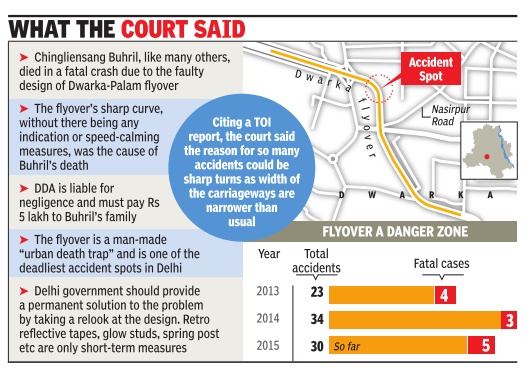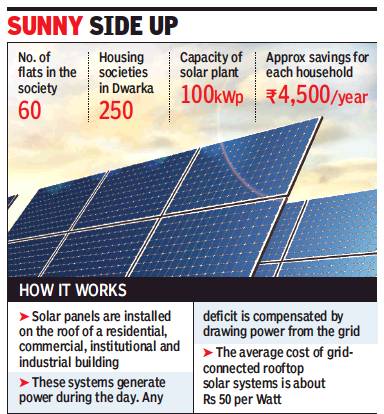Delhi: Dwarka
This is a collection of articles archived for the excellence of their content. |
Contents |
Dwarka-Palam flyover
The Times of India, Oct 17 2015

Sana Shakil
Faulty design makes it deadly spot The Dwarka-Palam flyover, which was described on Friday by additional sessions judge Kamini Lau as one of the “deadliest accidents spots“ in Delhi, has seen 30 mishaps this year alone with five fatalities, according to police records.The court's view that its “faulty“ design will continue to lead to accidents is backed by statistics that show around 90 road accidents have occurred on this stretch in the last three years. Though the number of accidents on this stretch has gone down after 2008, when there were 20 fatal accidents on there, the numbers remain alarming. The court's observations came while directing the flyover's maker, DDA, to pay Rs 5 lakh as compensation to the family of 21year-old Chingliensang Buhril of Manipur, who became the eighth victim of a road mishap on the flyover within a week in March 2009.
The judge also noted that DDA, which had constructed this flyover in 2006, had admitted it had not provided any safety measures like warning signs till 2012. In its arguments before the judge, DDA had claimed that the Delhi Police had never asked the civic body for any assistance in curbing accidents on the flyover. The court, however, disagreed and pointed out that there had been several instances when the Delhi Traffic Police had expressed concern but and an “indifferent“ DDA had done nothing about it.
Even six years after the deadly stretch claimed Buhril's life and those of many others, the situation has not changed. Accidents continue to take place there although some signboards and speed barriers have now been put up there. It is easy to see that the stretch requires glow studs to help motorists in low-light conditions.
The judge has asked the government to review the design of the flyover and come up with a permanent solution for the problem. The court said that the installa tion of retro-reflective tapes, glow studs and spring posts by DDA, that too “on the repeated prodding of the Delhi Traffic Police“, constituted only temporary measures when the problem needed a long-term solution.
“The question of the design being flawed having arisen and certain structural deficiencies having been noticed, there is a need for the Government of NCT of Delhi to intervene and a relook by an independent expert committee is needed to remedy the situation permanently ,“ the judge suggested.
Lakes, waterbodies
2015-19: three waterbodies revived
Jasjeev Gandhiok, August 12, 2019: The Times of India

From: Jasjeev Gandhiok, August 12, 2019: The Times of India
In 2013, residents of Dwarka had compiled a list of waterbodies in the area that had dried out completely and needed to be revived. The residents had approached the then lieutenant governor, who formed the area’s own waterbody monitoring committee comprising of experts and locals. While locals say nothing has been done on ground despite NGT orders, community participation has seen the revival of two waterbodies over the last four years. This monsoon, locals have revived a third waterbody in Dwarka’s Dhul Siras in Sector 25, which they say is the deepest of the three.
Diwan Singh, an activist and convener of Natural Heritage First who has been actively involved in the revival process, said work on this particular waterbody began four years ago. However, the channels for rainwater could be created only recently.
Locals from Dhul Siras in Dwarka and a local residents forum — Sukh Dukh Ke Saathi (SDKS) — were also involved in the revival process, approaching an NGT-appointed committee to facilitate work to dig drains. Meanwhile, plantation drives were carried out on a large scale around the waterbody to improve water retention. Singh said DDA helped them procure machines for the work as well.
“We have used a similar model to the waterbodies revived in Dwarka’s sector 20 and 23, diverting water from rainwater drains as well as creating slopes and channels for rainwater to automatically flow into it,” said Singh, adding that it is as deep as 25 metres in the centre. He also suggested making use of supply from the nearest sewage treatment plant to maintain the waterbody year-round.
The project is also being monitored by the NGT-appointed Waterbody Monitoring Committee, which is headed by Justice (retd) SP Garg.
Solar power
Shiv Bhole CGHS and rooftop solar plant
Dwarka society taps sun’s energy to light up homes, May 5, 2018: The Times of India

From: Dwarka society taps sun’s energy to light up homes, May 5, 2018: The Times of India
Becomes First CGHS To Install Rooftop Panels Linked To Grid
By installing rooftop solar plant, connected to a 100KW grid, the Shiv Bhole Cooperative Group Housing Society in Dwarka became the first CGHS to go live as part of BSES Rajdhani Power Limited’s (BRPL) solar city initiative.
The solar plant is the first one launched on January 7 this year, under the Solarise Dwarka initiative being implemented by BRPL in collaboration with Deutsche Gesellschaft für Internationale Zusammenarbeit (GIZ India) under its Indo-German solar partnership project. The plant was inaugurated by Dr Wolfram Klein, head of Division India, South Asia German Federal Ministry of Economic Cooperation and Development in presence of Amal Sinha, CEO-BRPL.
The solar plant installed at the housing society would save roughly Rs 4,500 annually for each of the 60 households in the society. The plant has been installed by Green Ripples Pvt Ltd following RESCO business model. RESCO model entails providing electricity as a service at a cost identified through the competitive bidding, which in this case is Rs 2.66/kWh net of generationbased incentive and is around Rs 2.40/kWh less than the tariff from BRPL.
The bidding was administered by the Indraprastha Power Generation Company Limited for 84MWp capacity. Residents of the society are quite enthusiastic about the solar plant.
Anant Kumar, president of the society’s association said, “In view of the potential cost savings and environmental benefits, the society members took an unanimous decision to install the rooftop solar”. He added, “The business model offered by the installer wherein the society doesn’t have to invest any amount, led to the quick decision.”
Solarise Dwarka initiative aims at raising awareness through outreach campaigns for aggregating demand of solar rooftop systems. On the occasion, Dr Winfried Damm, energy cluster coordinator at GIZ, said, “The solar plant will be able to offset around 32% of a resident’s annual carbon emission.”